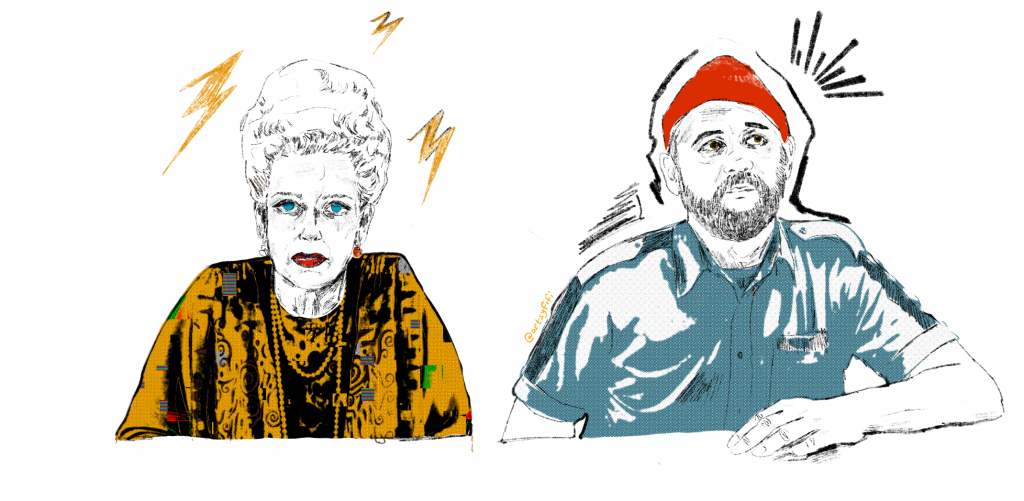It is no surprise, considering the extremely specific and accurately tailored nature of Wes Anderson’s films, that the stylistic decisions he makes are so widely discussed. From The Grand Budapest Hotel to Fantastic Mr Fox, the fashion choices in Wes Anderson’s films act as a powerful tool through which audiences are pulled into the unique spaces that his characters occupy. He has even gotten involved within the fashion world as director of a 2016 H&M advert Come Together and collaborated with Prada for a 2013 collection and another short film in 2015. His intricate attention to detail and his dedication to fashion statements make him the perfect director to start off our Fashion in Film series here at Quench Mag. Amy Wild and Suraya Kazzuz discuss some of their favourite fashion moments in Wes Anderson films below.
Words by Amy Wild
All film directors strive to have their own recognizable style: from Quentin Tarantino’s stylized dialogue and violent shootouts to David Lynch’s impressionist and mysterious films. All of the great directors put their own unique stamp on any script.
Wes Anderson is one of the most distinctive auteurs in contemporary cinema. For me, Anderson’s 2014 film The Grand Budapest Hotel marked a significant moment in cinema history. It uses distinctive art nouveau colour palettes throughout – mainly pale pink – to represent each character and to signpost the dreamlike tone of the film. One idiosyncratic character, who dresses in golden hues with extravagant patterns, paired with a tall, curled wig, striking red lipstick and a long pearl necklace, is Madame D, a wealthy, 84-year-old dowager.
Played by Tilda Swinton, a frequent Anderson collaborator, Madame D is a rich but paranoid art collector. She steals the eye of the viewer in every frame before her swift, unexpected death.
In her first appearance, she is dressed in a golden floor-length dress, pearl necklaces and diamond earrings. In an interview with Los Angeles Times, Milena Canonero, the Italian costume designer, describes how she developed this look. Canonero remarks that Madame D is ÔÇÿeccentric and beautiful’, and that Anderson employed a ÔÇÿgreat prosthetics makeup team to age Tilda Swinton to look old but still very attractive’. The design of the flamboyant orange dress was specifically interesting with its swirl mosaic style print. Wes Anderson envisioned that ÔÇÿshe collects Klimts’.
Gustav Klimt was a highly regarded Austrian painter known for his symbolist artwork. Madame D seems to be wearing a dress inspired by The Kiss or Portrait of Adele Bloch-Bauer I. Its golden abstract patterning is very similar to the design of her dress.
Klimt-inspired clothing was all over the runway before The Grand Budapest Hotel, from the designers from the likes of Aquilano. Rimondi in 2011, Christian Dior in 2008 couture and Alexander McQueen resort in 2013. So, it wasn’t surprising that Milena Canonero chose to dress such a lavish character in clothing that reflects and pays tribute to the Austrian artist’s work. Canonero stated that she ÔÇÿprinted a Klimt-inspired pattern for her velvet costumes. I rendered the whole look on Photoshop, including the hairstyle and the hat to go with it’. Madame D’s yellow abstract dress is definitely one to remember.
Madame D’s outfits cannot be pinpointed to any specific era as her outfit mixes up different decades and different fashion styles. In the lift scene, she is wearing a vivid golden dress – similar to those worn by Greta Garbo, Marlene Dietrich and Bette Davis in the early thirties. This is paired with a red and black velvet theatre coat with a silk lining and matching hat and gloves which date back further, to the Roaring Twenties, when women wrapped up in oversized furs and velvets to show off wealth and class. Madame D’s curled ÔÇÿupdo’ essences the style of La Belle Epoque in the 1870s and 80s, when hair represented ÔÇÿcrowning glory’. Madame D’s muddled but chic mash-mash of eras could represent her wish for the times of her youth when she lived lavishly in her hedonistic lifestyle.
Madame D’s appearances in The Grand Budapest Hotel are short but memorable. Her clothes give us a strong impression of her: a love for the Old-World ideals. We can imagine that the Grand Budapest Hotel keeps her in her youth.
Only Madame D could be worthy of upending the hotel’s dreamy status quo. Her clothes represent this, and her attitude to life: vivid, uncompromising, elegant and slightly mad.

Words by Suraya Kazzuz
Notoriously specific, each frame of Wes Andersons’ films are instantly recognisable as his own because of his attention to detail and intricate stylistic approach. Not only are his films extremely satisfying in their symmetry and mise-en-scene but also through their colour pallet. The Life Aquatic with Steve Zissou is an incredibly recognisable film and one which incorporates fashion as an integral part of the narrative.
The film acts as a homage to the real-life scuba-diving documentaries created by Jacques Cousteau, and as a result, many of the fashion choices that Anderson and his costume designer Milena Canonero act as reference points to these documentaries. The most recognisable look throughout the whole film is the red cap and light blue shirt, which also acts as a reference to Cousteau and his crew who famously wore very similar outfits. These colours, the primary red (the famous cap), yellow (Jane Winslett-Richardson’s tan shirt and trousers), blue (the shirt, trousers, and shoes of every crewmate) set the tone for the entire film. The satire and humour are only heightened by the bright, almost camp-looking, outfits that each crewmate wears.
A fashion statement that is perhaps most notable in the film is the Adidas trainers which to this day, almost 20 years following the release of the film, can sell for up to £500 online. They are an incredibly popular piece of memorabilia as they are not only hard to come by, but also extremely in demand. There are lots of videos that can be found on YouTube in which creators instruct their audiences on how to recreate the iconic shoes and many custom trainer crafters can sell their own remakes of the Adidas trainers at quite high prices.
Through colour blocking, referencing and specificity, Wes Anderson is able to create an entirely new and exciting world. He works to draw audiences into these tailored worlds which adds a sense of fantasy, and sometimes satire, to his films as a whole. As always, Anderson’s fashion statements only work to heighten his narratives and serve the plot and the audience ÔÇô an incredibly effective technique and one that has had an impact on fans years later.


